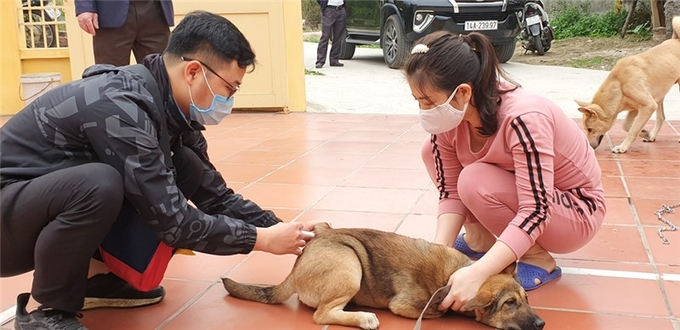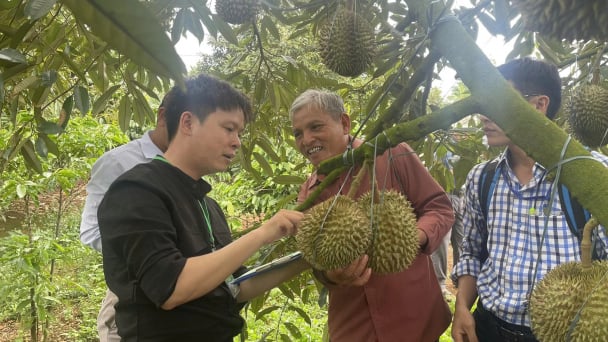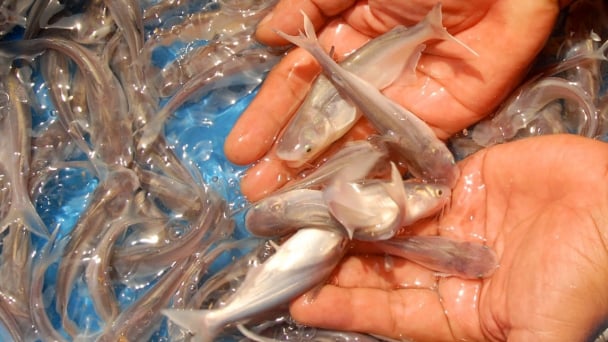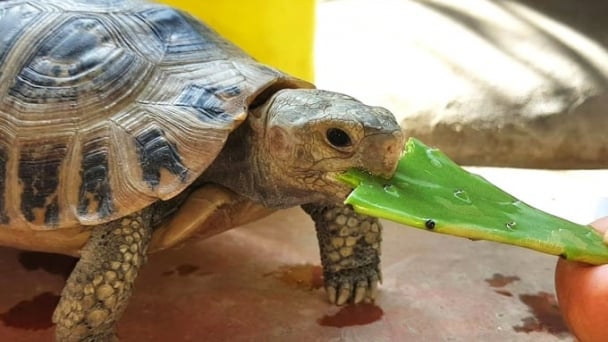May 31, 2025 | 14:38 GMT +7
May 31, 2025 | 14:38 GMT +7
Hotline: 0913.378.918
May 31, 2025 | 14:38 GMT +7
Hotline: 0913.378.918

People bring their dogs and cats to a rabies vaccination site at the residential area's cultural house. Photo: Vu Cuong.
Implementing the direction of the People's Committee of Quang Ninh province on strengthening measures to control and prevent rabies in the vicinity, the leaders of the People's Committee of Uong Bi city have just issued an official dispatch requesting the Chairmen of the People's Committees of communes and wards as well as Heads of relevant departments, offices and units to implement the peak month of rabies prevention and control, taking place from March 15, 2025 to April 15, 2025.
The main focus of the campaign is to strictly manage dog herds and thoroughly vaccinate them to prevent the risk of rabies, thus protecting people's health and safety. According to Ngo Thi Tan Hop, Deputy Director of Uong BI City Agricultural Technical Services Center, the total number of dogs and cats raised in the area is currently estimated at over 8,000, concentrated in the wards of Vang Danh, Trung Vuong, Phuong Nam, and Phuong Dong.
Uong Bi City People's Committee has requested to review and accurately count the number of households raising dogs and cats in each residential area to thoroughly manage and vaccinate against rabies.
Households are required to commit to declaring and registering their dogs, keeping them within their family premises, keeping them on leashes, and complying with rabies prevention and control regulations according to the Veterinary Law and the Law on Prevention and Control of Infectious Diseases. At the same time, neighboring groups need to organize a peak period of rabies vaccination, ensuring that at least 90% of dogs and cats are vaccinated and receive additional vaccinations for any cases that arise.
Communes and wards should strengthen communication and raise people's awareness of pet management, especially rabies vaccination and preventive treatment when bitten by dogs and cats. Local authorities will strictly handle violations of the law in raising and managing pets and deal with organizations and individuals failing to comply with regulations which lead to serious consequences.
"Rabies epidemics always have many complicated and unpredictable developments, with high potential risk of outbreaks. Along with the efforts to prevent the epidemic by relevant agencies, every dog and cat owner in the city needs to raise awareness and responsibility to strictly implement regulations on pet management, and fully vaccinate dogs and cats against rabies.
“In cases of dogs and cats suspected of having rabies, or people being scratched or bitten by dogs and cats suspected of having rabies, people must promptly inform the Medical Center, the City Agricultural Technical Service Center and the People's Committee of the commune or ward where the incident occurred to receive instructions on vaccination and other treatment measures. The synchronous, complete and timely implementation of rabies prevention and control measures will contribute to effectively preventing epidemics and protecting the health of the community," said Deputy Director Ngo Thi Tan Hop.

Veterinary staff of Uong Bi city inject rabies vaccine into dogs. Photo: Vu Cuong.
Previously, in September 2023, V.D.T., born in 2016, residing in Den Cong 1 area, Trung Vuong ward (Uong Bi city) was bitten by D.V.T.'s dog (not vaccinated against rabies) on the left forearm, causing two deep cuts. The patient was then taken to the Vietnam - Sweden Uong Bi Hospital for wound suturing and tetanus vaccination. During his stay in the hospital, from September 26, the patient was vaccinated against rabies with 3 doses of Verorab vaccine at the service vaccination room in Uong Bi. No rabies serum was injected.
On October 1, the patient was stable, the family asked to be discharged from the hospital, the family took the child to be tested for rabies and treated with traditional medicine in Hai Duong. On October 10, the child had a high fever of over 39 degrees plus headache. He was then admitted to the Pediatrics Department - Vietnam - Sweden Uong Bi Hospital in a state of fever, lethargy, no convulsions, no fear of water, no fear of light and was diagnosed with viral meningitis, rabies not ruled out. By 4:00 p.m. on October 12, the patient's condition gradually worsened and he was transferred to the National Children's Hospital.
At the Intensive Care Unit - National Children's Hospital, the patient showed symptoms of convulsions, fear of noise, fear of water, increased salivation, and was diagnosed with suspected rabies meningitis. On October 13, the first rabies virus test result was negative. On October 14, the patient with myocarditis was treated with sedation, muscle relaxants, and mechanical ventilation.
The patient still had symptoms of rabies, and the hospital took a second rabies test sample. On October 15, the patient's condition worsened, with a very serious prognosis, and at 10:22 p.m. the same day, the patient died at home.
Translated by Samuel Pham

(VAN) For the durian industry to succeed, the value chain must fulfill its commitments to the government, the community, and international partners.

(VAN) Vaccinating juvenile pangasius helps reduce disease, antibiotic use, and farming costs, increasing profits for export-oriented farmers in An Giang.

(VAN) Due to a limited supply of workforce and competitive recruitment requirements, businesses struggle to retain talented veterinary human resources.

(VAN) WOAH’s guidance aims to mitigate disease risks through a One Health approach that balances economic, conservation, and public health interests.

(VAN) Ms. Nguyen Thi Dung, Deputy Director of Ngoc Hoang Cooperative, shared about the journey of bringing dragon fruit to Europe, achieving annual revenues in the billions of VND.

(VAN) Bamboo products from Thang Tho Bamboo Cooperative have reached many countries around the world, while also creating jobs for local workers.

(VAN) The Management Board of Con Dao National Park reported that a green sea turtle, tagged in the Philippines, has traveled thousands of kilometers to lay 84 eggs on Bay Canh Islet.